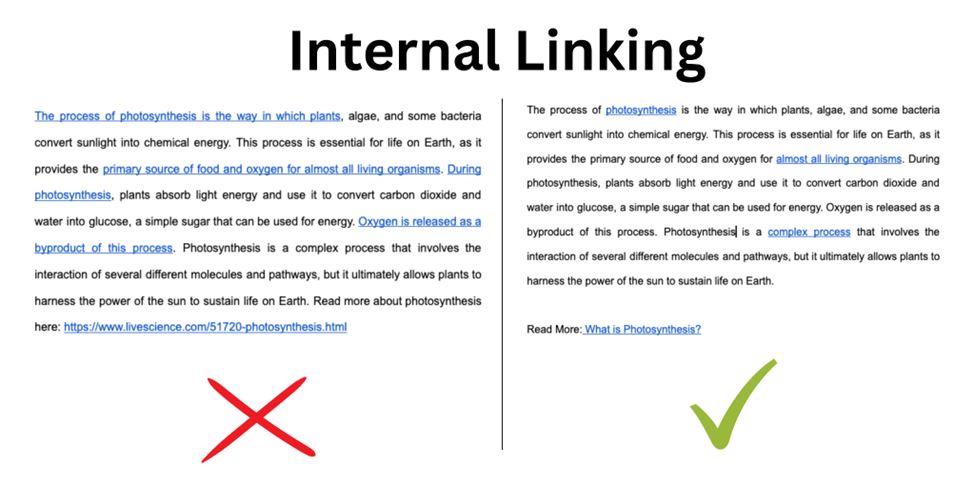
An internal link structure is an essential part of any blog, as it not only helps to improve the user experience but also offers a range of benefits for Search Engine Optimization (SEO).
By including internal links in your blog posts, you can help search engines understand the hierarchy and relevance of your content, leading to improved visibility and higher rankings in search results.
In this blog post, we will explore seven benefits of having a strong internal link structure for your blog.
What are Internal Links?
Internal linking refers to the practice of including links to other pages on your website within your content. These links can be included in the main body of your text, or they can be added in the form of a menu or navigation bar.
You have most likely come across these before when reading through a website. They may look something like this:
Internal linking is an important part of any website, as it helps to improve the user experience and provide search engines with information about the hierarchy and relevance of your content.
What is an Internal Link Structure?
An internal link structure refers to the organization and arrangement of the internal links on your website. A well-designed internal link structure can help to improve the user experience by making it easier for visitors to find and access the information they are looking for.
It can also help to improve the search engine optimization of your website by providing search engines with additional information about the relationship between your pages.
Internal linking is an essential part of any website, as it not only helps to improve the user experience but also provides a range of benefits for search engine optimization.
By including internal links in your content, you can help search engines understand the hierarchy and relevance of your pages, leading to improved visibility and higher rankings in search results. These are just the tip of the iceberg, let’s dive into detail into the 7 Benefits that having a strong internal link structure can provide for your blog.
What are the Benefits of Having a Strong Internal Link Structure?
Below, we have the 7 benefits of having a strong internal link structure for your blog. Namely, they are:
- Improved Navigation
- Reduced Bounce Rate
- Improved Search Engine Rankings
- Stronger link equity
- Increased pageviews
- Increased revenue potential
- Improved keyword targeting
So let’s jump in and see how internal linking can help provide these 7 benefits.
1. Improved Navigation
Internal linking can help to improve the navigation of your blog by making it easier for readers to find the information they are looking for. By including links to relevant posts within your blog post, you can guide readers to other valuable information on your site, making it more likely that they will continue to browse and engage with your content.
This can be especially useful for blogs with a large amount of content, as it can help to organize and structure your content in a way that is easy for readers to understand.
A well-designed internal link structure can also help to improve the user experience on your blog by making it easier for readers to navigate your site. By including clear and intuitive links in your posts, you can help readers find the information they are looking for and reduce the risk of them becoming frustrated or lost.
This can be especially important for blogs with a complex or hierarchical structure, as it can help to make your content more accessible and easier to understand.
In addition, by including links to related content in your posts, you can encourage readers to explore more of your site and engage with a wider range of your content.
2. Reduced Bounce Rate
Internal linking can help to reduce the bounce rate on your blog by improving the user experience and making it more likely that readers will stay on your site.
Bounce rate is a measure of how many visitors leave your site after viewing only one page, and it is an important factor in determining the overall performance of your blog.
By including internal links in your posts, you can guide readers to other valuable information on your site, making it more likely that they will continue to browse and engage with your content. This can help to reduce the number of visitors who leave your site after viewing only one page, improving your overall bounce rate.
In addition to improving the user experience, internal linking can also help to reduce bounce rate by making it easier for readers to find the information they are looking for. If a reader arrives on your blog and cannot find the information they are looking for, they are more likely to become frustrated and leave the site.
By including clear and intuitive internal links in your posts, you can help readers find the information they are looking for and reduce the risk of them becoming frustrated and leaving your site. This can help to improve the overall user experience on your blog and reduce the bounce rate.
3. Improved Search Engine Rankings

Internal linking can help to improve the search engine optimization of your blog by providing search engines with additional information about the relationship between your pages.
When search engines crawl your site, they use the links between your pages to understand the hierarchy and relevance of your content.
By including internal links in your posts, you can provide search engines with additional information about the relationship between your pages, which can help to improve their understanding of your content and improve your visibility in search results.
In addition to providing search engines with information about the relationship between your pages, internal linking can also help to improve your search engine rankings by increasing the amount of time that readers spend on your site.
Search engines use a variety of factors to determine the relevance and quality of a website, and one of these factors is the amount of time that visitors spend on the site. By including internal links in your posts, you can encourage readers to browse and engage with more of your content, which can help to increase the amount of time that they spend on your site.
This can improve your search engine rankings and make it more likely that your blog will appear near the top of search results.
4. Stronger Link Equity
Internal linking can provide stronger link equity to your blog by distributing the value of external links more evenly across your site.
Link equity is a measure of the value that search engines assign to a link, and it is an important factor in determining the search engine rankings of a website. When a website receives a high-quality external link, the link equity is passed from the linking site to the linked site, improving its search engine rankings.
By including internal links in your posts, you can distribute the link equity from external links more evenly across your site. This can help to improve the search engine rankings of individual pages on your blog, as well as the overall search engine performance of your site.
For example, if your blog receives a high-quality external link to one of your posts, you can use internal linking to pass some of the link equity to other pages on your blog. This can help to improve the search engine rankings of those pages and make your blog more visible in search results.
In addition, by using internal linking to distribute the link equity from external links, you can make your blog more resilient to changes in the search algorithms and external links
5. Increased Pageviews

Internal linking can increase pageviews on your blog by making it easier for readers to find and access related content. By including links to other posts within your blog post, you can guide readers to additional information on your site, which can increase the amount of time that they spend on your site and the number of pages that they view.
This can be especially useful for blogs with a large amount of content, as it can help to organize and structure your content in a way that is easy for readers to understand.
In addition to improving the user experience, internal linking can also help to increase pageviews by making your content more engaging and interesting.
By including links to related content in your posts, you can encourage readers to explore more of your site and engage with a wider range of your content. This can help to keep readers on your site for longer and increase the number of pages that they view.
Furthermore, by linking to high-quality content within your posts, you can provide readers with additional value and make your content more valuable and interesting, which can increase the chances that they will share your content with others and bring new readers to your site.
6. Increased Revenue Potential
Internal linking can help to increase the revenue potential of your blog by improving the user experience and search engine optimization of your site.
By making it easier for readers to find and access the information they are looking for, internal linking can help to increase the amount of time that visitors spend on your site, which can in turn lead to increased revenue potential. For example, if you have ads on your blog, a higher number of pageviews and longer visit duration can lead to more ad impressions and higher ad revenue.
In addition to increasing the number of pageviews and visit duration, internal linking can also help to increase the revenue potential of your blog by improving its search engine rankings. By providing search engines with additional information about the relationship between your pages, internal linking can help to improve the search engine optimization of your site and make it more likely that your blog will appear near the top of search results.
This can increase the visibility of your blog and attract more traffic, which can in turn lead to increased revenue potential through advertising or other monetization strategies.
Furthermore, by linking to high-quality content within your posts, you can provide readers with additional value and make your content more valuable and interesting, which can increase the chances that they will share your content with others and bring new readers to your site.
7. Improved Keyword Targeting
One of the key benefits of internal linking is that it can help with keyword targeting. When creating internal links, it’s important to use relevant keywords as the anchor text. This helps to indicate to search engines which keywords are important for a particular page.
For example, if you have a page on your blog about “dog training,” you could add a hyperlink with the anchor text “dog training” to another page on your blog that also mentions this topic. This can help to improve the ranking of that page for the keyword “dog training,” which can help to drive more organic traffic to the blog.
Additionally, internal linking can help to distribute the “link juice” from one page to another, which can help to improve the overall authority of the website in the eyes of search engines for ranking for certain keywords. When one page on a website links to another page with a target keyword, it passes on some of its own authority to that page.
By linking to pages on your own website, you can help to distribute link juice for specific target keywords throughout your website, which can help to improve the overall authority of the website in the eyes of search engines.
This can help to improve the ranking of all pages on the website for certain keywords, not just the pages that you’ve linked to.
Some Tips for Effective Internal Linking
To get you started on your journey to building a stronger internal link structure for your own blog to reap the benefits we mentioned above:
- Use relevant keywords as the anchor text for your internal links. This can help to indicate to search engines which keywords are important for a particular page, which can help to improve the ranking of that page for those keywords.
- Link to pages that are closely related to the content of the page you’re linking from. This can help to improve the user experience by providing readers with more relevant information and making it easier for them to find what they’re looking for.
- Use descriptive link text that accurately reflects the content of the page you’re linking to. This can help to improve the user experience by giving readers a better idea of what they can expect to find on the page they’re being linked to.
- Don’t overdo it with the internal linking. Too many internal links can be overwhelming for readers and may actually hurt the user experience. It’s best to use internal linking sparingly and only when it adds value for the reader.

Alternatively, you can read our guide for The 11 Best Practices For Writing SEO-Friendly Content! We provide some great tips that you can use alongside internal links to boost your website’s rankings.
Wrap Up and Final Words
In conclusion, internal linking is an important part of SEO for bloggers. By creating links between pages and posts on their own blog, bloggers can improve the navigation, user experience, and search engine rankings of their site.
In this article, we have explored the seven benefits of having a strong internal link profile for blogs and hopefully given you the ideas to move forward to creating stronger websites and rank higher on search engines.

Shane Duggan is a blogger with a strong passion in the Technology and E-Learning Niches. He writes articles to help readers become more familiar with learning new skills online at shaneduggan.com. He is an enthusiastic writer and content creator at heart.